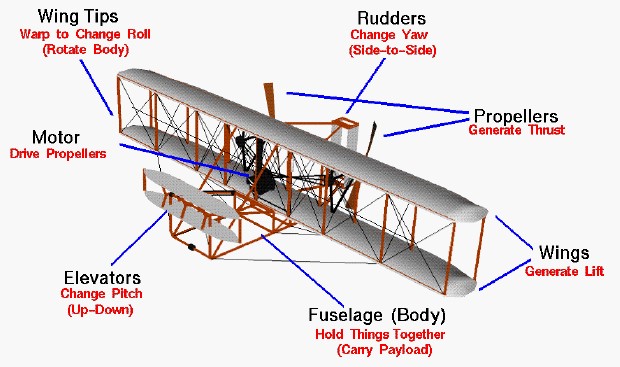Parts of the Aircraft

This slide shows the parts of the Wright brothers’ 1903 airplane and their functions. The various parts of the aircraft were designed and perfected over four years of wind tunnel, kite, and glider flight testing, leading to the first self powered, heavier than air, man controlled flight in December of 1903.
Generating Lift and Overcoming Drag
You can compare the parts and functions of this aircraft with a modern airliner. While this aircraft does not look like a modern airliner, the basic forces acting on the airplanes are exactly the same. For any airplane to fly, one must overcome the weight of the airplane itself, the fuel, and the pilot. The wings generate most of the lift to hold the plane in the air. To generate lift, the airplane must be pushed through the air. But the air resists the motion of the aircraft and this opposing force is called the airplane drag. To overcome the drag, a propulsion system is used generate thrust. The Wright brothers used twin pusher propellers located behind the wings and powered by a small motor for their propulsion system.
Controlling Pitch, Yaw, and Roll
One of the major breakthroughs of the Wright brothers was the ability to control and maneuver their aircraft. An aircraft must be controlled about three principal axes; an up and down movement of the nose, which is called pitch, a side to side movement of the nose, which is called yaw, and an up and down movement of the wing tips, which is called roll. The Wright’s used an all-moving elevator at the front of the aircraft to control pitch. This is quite different from modern aircraft which use either elevators at the rear of the aircraft horizontal stabilizer or all-moving stabilators to control pitch.
From the glider flights of 1901, the Wright’s identified the need for a rudder at the rear of the aircraft to control yaw and to allow coordinated turns. Roll control was provided by wing warping which is twisting the wing tips to increase or decrease lift on the outer sections of the wing. Changing the rear portion of a wing will change the amount of force that the wing produces. The ability to change forces gives us a means of controlling and maneuvering the airplane. Modern aircraft use ailerons or spoilers to accomplish the same control.
The fuselage, or body of the airplane, holds all the pieces together. For the Wright brothers, this was a rather light, framed structure which did not require covering because of the low flight speed. The pilot of the Wright flyer would lie on the wing next to the engine. So there were no seats, or seat belts, on this first aircraft.
